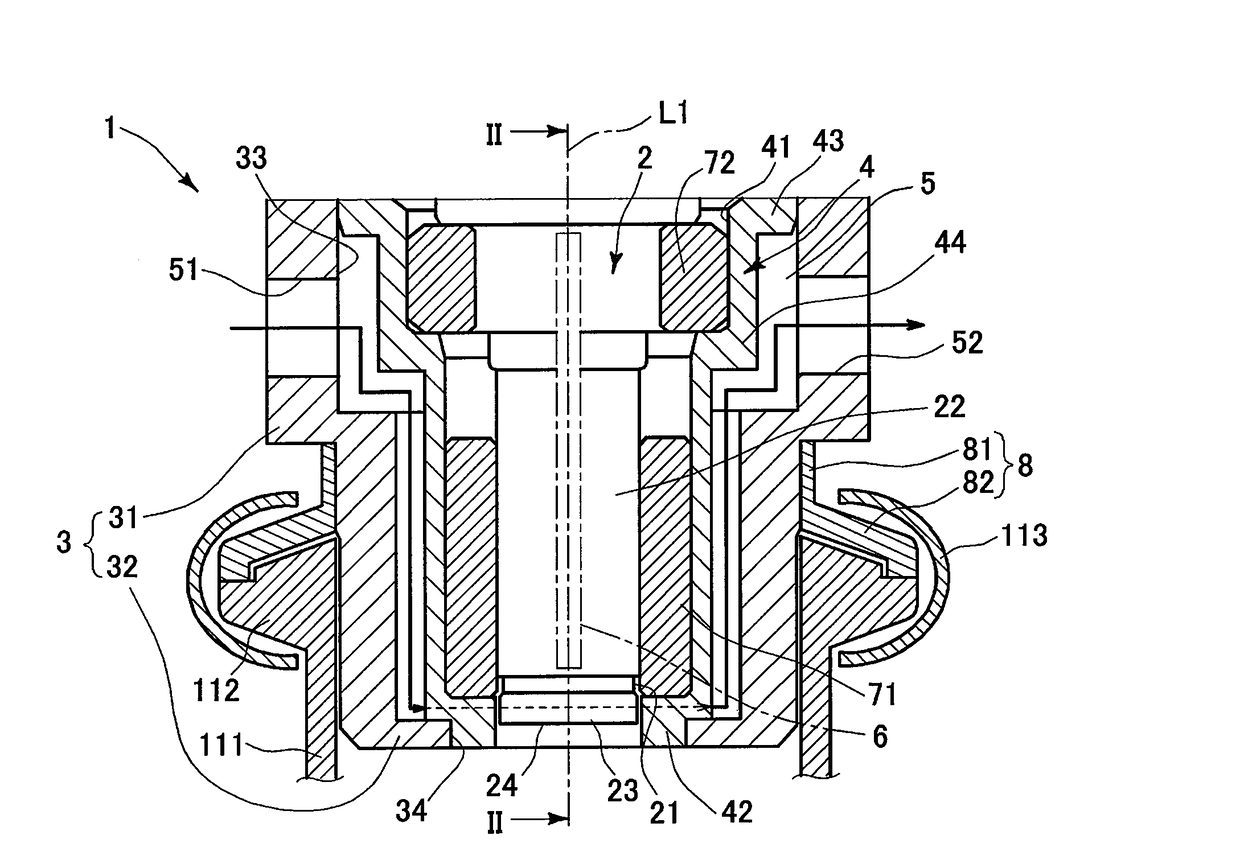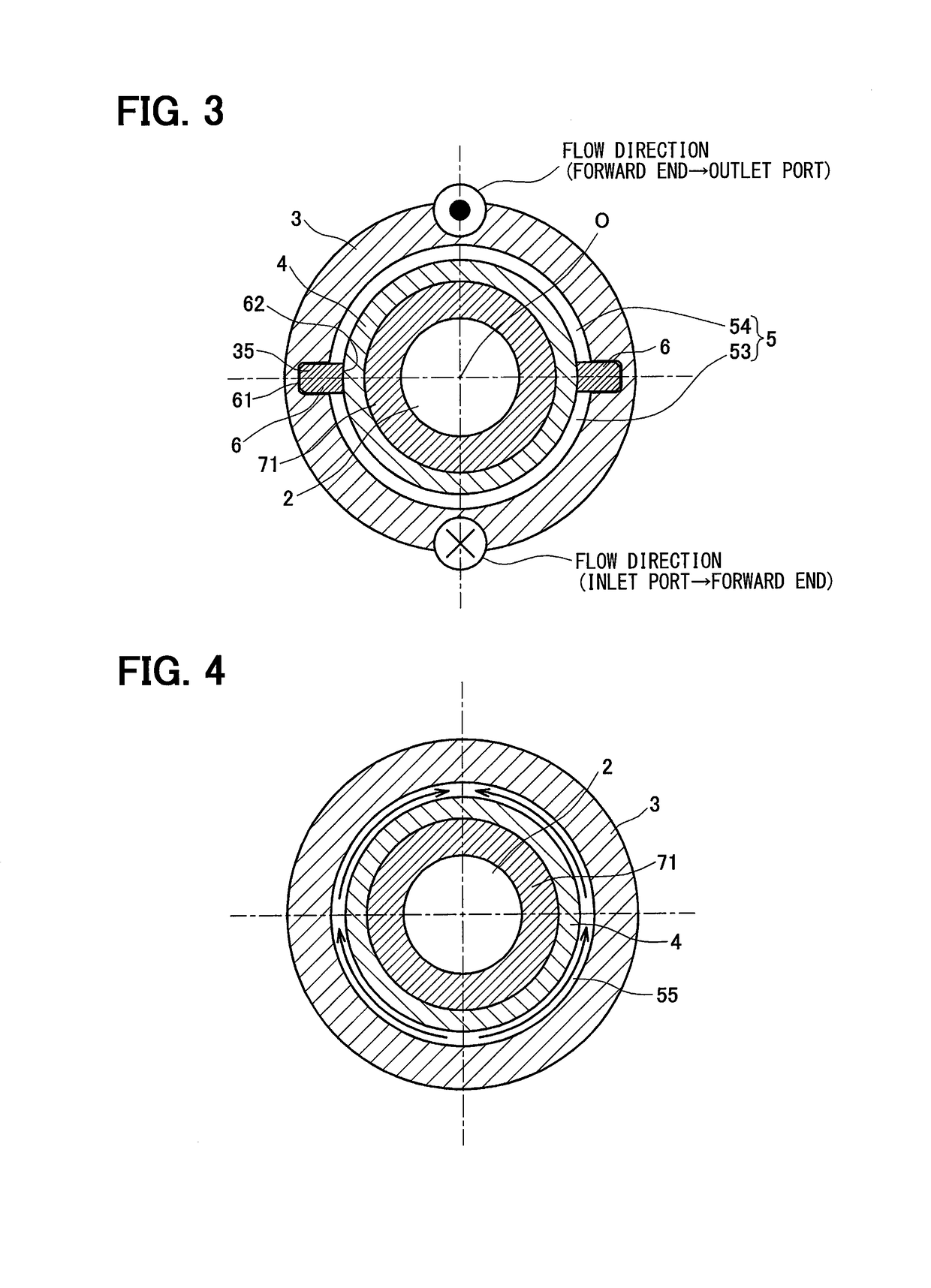Cooling device for injector
a technology of fluid injection valve and cooling device, which is applied in the direction of machines/engines, mechanical equipment, separation processes, etc., can solve the problem of difficult to precisely control the amount of urea aqueous solution injection, and achieve the effect of increasing the cooling performance of the fluid injection valv
- Summary
- Abstract
- Description
- Claims
- Application Information
AI Technical Summary
Benefits of technology
Problems solved by technology
Method used
Image
Examples
second embodiment
[0132]Next, a second embodiment of the present disclosure will be explained by focusing on those portions different from the first embodiment. As shown in FIGS. 8 and 9, the partitioning wall 6 (the baffle plate 6) is different from that of the first embodiment. Each of the baffle plates 6 is composed of an inside plate portion 65 and an outside plate portion 66, when viewed it in a cross section on a plane perpendicular to the center axis line L1 of the injector 2. The inside plate portion 65 extends in the circumferential direction of the injector 2 around its center position “◯” (that is, in the circumferential direction of the body member 4) and is in contact with the outer peripheral surface of the body member 4. More exactly, the inside plate portion 65 is in contact with the body member 4 at its entire inner surface opposing to the outer peripheral surface of the body member 4. In other words, the inside plate portion 65 and the body member 4 are in a surface-to-surface conta...
third embodiment
[0139]In the second embodiment shown in FIG. 9, the bent portion 671 is formed at the portion close to the forward end 67 of the outside plate portion 66.
[0140]However, the baffle plate 6 can be formed in a shape, as shown in FIG. 10. The baffle plate 6 has the inside plate portion 65 and an outside plate portion 68, as in the same manner to the second embodiment. The inside plate portion 65 has the same shape to that of the second embodiment of FIG. 9. In the third embodiment, the outside plate portion 68 and a forward end portion 69 are different from those of the second embodiment of FIG. 9.
[0141]In the third embodiment, as shown in FIG. 10, no bent portion is formed in the outside plate portion 68 so that the forward end portion 69 is formed in a straightly extending shape. An end surface 691 at the forward end portion 69 is inclined with respect to the inner peripheral surface of the cover member 3. Only an edge portion 692 at the end surface 691 is in contact with the inner pe...
fourth embodiment
[0143]Next, a fourth embodiment of the present disclosure will be explained by focusing on those portions different from the first embodiment. In the first embodiment, for example, as shown in FIG. 3, the baffle plates 6 are located at such positions, which are opposed to each other in the radial direction on the straight line passing over the center position “◯” of the injector 2.
[0144]However, according to the fourth embodiment, as shown in FIG. 11, an angle “θ2” formed at the center position “◯” of the injector 2 between the baffle plates 6 in the inlet-side fluid space 53 is made smaller than 180 degrees. In the present embodiment, an angle “θ3” formed at the center position “◯” between the baffle plates 6 in the outlet-side fluid space 54 is larger than 180 degrees.
[0145]According to the above structure of the fourth embodiment, it is possible to make smaller a contact surface area between a wall surface of the inlet-side fluid space 53 and the cooling water. It is thereby poss...
PUM
| Property | Measurement | Unit |
|---|---|---|
| inlet-side angle | aaaaa | aaaaa |
| center angle | aaaaa | aaaaa |
| angle | aaaaa | aaaaa |
Abstract
Description
Claims
Application Information
 Login to View More
Login to View More - R&D
- Intellectual Property
- Life Sciences
- Materials
- Tech Scout
- Unparalleled Data Quality
- Higher Quality Content
- 60% Fewer Hallucinations
Browse by: Latest US Patents, China's latest patents, Technical Efficacy Thesaurus, Application Domain, Technology Topic, Popular Technical Reports.
© 2025 PatSnap. All rights reserved.Legal|Privacy policy|Modern Slavery Act Transparency Statement|Sitemap|About US| Contact US: help@patsnap.com



